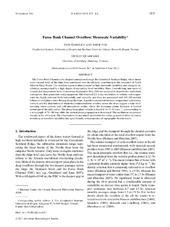Faroe Bank Channel Overflow: Mesoscale Variability
Peer reviewed, Journal article
Published version

Åpne
Permanent lenke
https://hdl.handle.net/1956/13063Utgivelsesdato
2011-11Metadata
Vis full innførselSamlinger
- Geophysical Institute [1198]
Originalversjon
https://doi.org/10.1175/jpo-d-11-035.1Sammendrag
The Faroe Bank Channel is the deepest connection through the Greenland–Scotland Ridge, where dense water formed north of the ridge flows southward over the sill crest, contributing to the formation of North Atlantic Deep Water. The overflow region is characterized by high mesoscale variability and energetic os- cillations, accompanied by a high degree of sea surface level variability. Here, 2-month-long time series of velocity and temperature from 12 moorings deployed in May 2008 are analyzed to describe the oscillations and explore their generation and propagation. The observed 2.5–5-day oscillations in velocity and temper- ature are highly coherent both horizontally and vertically, and they are associated with 100–200-m-thick boluses of cold plume water flowing along the slope. A positive correlation between temperature and relative vorticity and the distribution of clockwise/counterclockwise rotation across the slope suggest a train of al- ternating warm cyclonic and cold anticyclonic eddies, where the maximum plume thickness is located downslope of the eddy center. The along-slope phase velocity is found to be 25–60 cm s-1, corresponding to a wavelength of 75–180 km, while the vertical phase propagation is downward. The oscillations are present already in the sill region. The observations do not match predictions for eddies generated either by vortex stretching or baroclinic instability but agree broadly with properties of topographic Rossby waves.